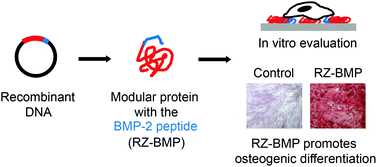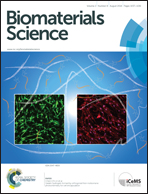Incorporating the BMP-2 peptide in genetically-engineered biomaterials accelerates osteogenic differentiation†
Abstract
Protein-based biomaterials have emerged as powerful tools for tissue engineering applications. Recombinant DNA techniques can be used to precisely tune material properties at the molecular level, and multiple peptide modules can be incorporated into a single material. Here, we genetically engineered biomaterials that incorporate a peptide derived from bone morphogenetic protein-2 (BMP-2) and investigated whether the BMP-2 peptide, within the context of these materials, can promote stem cells to produce bone matrix and synergize with a cell-binding sequence (RGD). Our study is the first to demonstrate that when the BMP-2 peptide is incorporated within the backbone of protein-based biomaterials, it is active and accelerates osteogenic differentiation of mesenchymal stem cells. In particular, cells seeded on proteins containing the BMP-2 peptide had increased levels of alkaline phosphatase (AP) activity, calcium deposition, and expression of bone-related genes. However, the BMP-2 peptide did not synergize with the RGD cell-binding domain within the context of these protein-based materials. Overall, these results suggest that incorporation of the BMP-2 peptide within the context of modular proteins is a successful strategy for engineering biomaterials for applications in bone tissue engineering.


 Please wait while we load your content...
Please wait while we load your content...